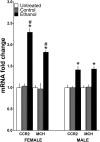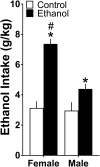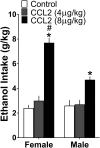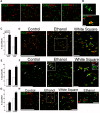Hypothalamic CCL2/CCR2 Chemokine System: Role in Sexually Dimorphic Effects of Maternal Ethanol Exposure on Melanin-Concentrating Hormone and Behavior in Adolescent Offspring
- PMID: 30201767
- PMCID: PMC6191525
- DOI: 10.1523/JNEUROSCI.0637-18.2018
Hypothalamic CCL2/CCR2 Chemokine System: Role in Sexually Dimorphic Effects of Maternal Ethanol Exposure on Melanin-Concentrating Hormone and Behavior in Adolescent Offspring
Abstract
Clinical and animal studies show that ethanol exposure and inflammation during pregnancy cause similar behavioral disturbances in the offspring. While ethanol is shown to stimulate both neuroimmune and neurochemical systems in adults, little is known about their anatomical relationship in response to ethanol in utero and whether neuroimmune factors mediate ethanol's effects on neuronal development and behavior in offspring. Here we examined in female and male adolescent rats a specific population of neurons concentrated in lateral hypothalamus, which coexpress the inflammatory chemokine C-C motif ligand 2 (CCL2) or its receptor CCR2 with the orexigenic neuropeptide, melanin-concentrating hormone (MCH), that promotes ethanol drinking behavior. We demonstrate that maternal administration of ethanol (2 g/kg/d) from embryonic day 10 (E10) to E15, while having little impact on glia, stimulates expression of neuronal CCL2 and CCR2, increases density of both large CCL2 neurons colocalizing MCH and small CCL2 neurons surrounding MCH neurons, and stimulates ethanol drinking and anxiety in adolescent offspring. We show that these neuronal and behavioral changes are similarly produced by maternal administration of CCL2 (4 or 8 μg/kg/d, E10-E15) and blocked by maternal administration of a CCR2 antagonist INCB3344 (1 mg/kg/d, E10-E15), and these effects of ethanol and CCL2 are sexually dimorphic, consistently stronger in females. These results suggest that this neuronal CCL2/CCR2 system closely linked to MCH neurons has a role in mediating the effects of maternal ethanol exposure on adolescent offspring and contributes to the higher levels of adolescent risk factors for alcohol use disorders described in women.SIGNIFICANCE STATEMENT Ethanol consumption and inflammatory agents during pregnancy similarly increase alcohol intake and anxiety in adolescent offspring. To investigate how neurochemical and neuroimmune systems interact to mediate these disturbances, we examined a specific population of hypothalamic neurons coexpressing the inflammatory chemokine CCL2 and its receptor CCR2 with the neuropeptide, melanin-concentrating hormone. We demonstrate in adolescent offspring that maternal administration of CCL2, like ethanol, stimulates these neurons and increases ethanol drinking and anxiety, and these effects of ethanol are blocked by maternal CCR2 antagonist and consistently stronger in females. This suggests that neuronal chemokine signaling linked to neuropeptides mediates effects of maternal ethanol exposure on adolescent offspring and contributes to higher levels of adolescent risk factors for alcohol use disorders in women.
Keywords: CCR2 antagonist; anxiety; ethanol drinking; lateral hypothalamus; neuroimmune; prenatal.
Copyright © 2018 the authors 0270-6474/18/389073-19$15.00/0.
Figures









Similar articles
-
CCL2/CCR2 system in neuroepithelial radial glia progenitor cells: involvement in stimulatory, sexually dimorphic effects of maternal ethanol on embryonic development of hypothalamic peptide neurons.J Neuroinflammation. 2020 Jul 10;17(1):207. doi: 10.1186/s12974-020-01875-5. J Neuroinflammation. 2020. PMID: 32650794 Free PMC article.
-
Prenatal exposure to ethanol stimulates hypothalamic CCR2 chemokine receptor system: Possible relation to increased density of orexigenic peptide neurons and ethanol drinking in adolescent offspring.Neuroscience. 2015 Dec 3;310:163-75. doi: 10.1016/j.neuroscience.2015.09.020. Epub 2015 Sep 10. Neuroscience. 2015. PMID: 26365610 Free PMC article.
-
CCL2/CCR2 Chemokine System in Embryonic Hypothalamus: Involvement in Sexually Dimorphic Stimulatory Effects of Prenatal Ethanol Exposure on Peptide-Expressing Neurons.Neuroscience. 2020 Jan 1;424:155-171. doi: 10.1016/j.neuroscience.2019.10.013. Epub 2019 Nov 6. Neuroscience. 2020. PMID: 31705896 Free PMC article.
-
Role of melanin-concentrating hormone in drug use disorders.Brain Res. 2020 Aug 15;1741:146872. doi: 10.1016/j.brainres.2020.146872. Epub 2020 May 1. Brain Res. 2020. PMID: 32360868 Review.
-
Melanin-concentrating hormone neuron system: the Wide Web that controls the feeding.Anat Sci Int. 2002 Sep;77(3):149-60. doi: 10.1046/j.0022-7722.2002.00027.x. Anat Sci Int. 2002. PMID: 12422407 Review.
Cited by
-
CCL2/CCR2 system in neuroepithelial radial glia progenitor cells: involvement in stimulatory, sexually dimorphic effects of maternal ethanol on embryonic development of hypothalamic peptide neurons.J Neuroinflammation. 2020 Jul 10;17(1):207. doi: 10.1186/s12974-020-01875-5. J Neuroinflammation. 2020. PMID: 32650794 Free PMC article.
-
Choline Plus Working Memory Training Improves Prenatal Alcohol-Induced Deficits in Cognitive Flexibility and Functional Connectivity in Adulthood in Rats.Nutrients. 2020 Nov 14;12(11):3513. doi: 10.3390/nu12113513. Nutrients. 2020. PMID: 33202683 Free PMC article.
-
Melanin-Concentrating Hormone (MCH): Role in Mediating Reward-Motivated and Emotional Behavior and the Behavioral Disturbances Produced by Repeated Exposure to Reward Substances.Int J Mol Sci. 2025 Jul 24;26(15):7143. doi: 10.3390/ijms26157143. Int J Mol Sci. 2025. PMID: 40806293 Free PMC article. Review.
-
Embryonic ethanol exposure and optogenetic activation of hypocretin neurons stimulate similar behaviors early in life associated with later alcohol consumption.Sci Rep. 2024 Feb 6;14(1):3021. doi: 10.1038/s41598-024-52465-x. Sci Rep. 2024. PMID: 38321123 Free PMC article.
-
Prenatal Alcohol Exposure in Rats Diminishes Postnatal Cxcl16 Chemokine Ligand Brain Expression.Brain Sci. 2020 Dec 15;10(12):987. doi: 10.3390/brainsci10120987. Brain Sci. 2020. PMID: 33333834 Free PMC article.
References
-
- Adachi N, Suzuki S, Matsuoka H, Fushimi S, Ono J, Ohta KI, Hirai Y, Miki T, Koshimizu H (2018) Corticotropin-releasing hormone-binding protein is up-regulated by brain-derived neurotrophic factor and is secreted in an activity-dependent manner in rat cerebral cortical neurons. J Neurochem. Advance online publication. Retrieved Jan. 22, 2018. doi: 10.1111/jnc.14310. - DOI - PubMed
Publication types
MeSH terms
Substances
Grants and funding
LinkOut - more resources
Full Text Sources
Other Literature Sources
